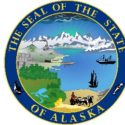Alaska became the 49th state in 1959. It’s the largest state and it has the smallest population. It’s separated from the rest of the states by the nation of Canada.
The U.S. bought Alaska from Russia in 1867. Russia had been trying to sell off Alaska for about a decade, since they were badly in debt after the Crimean War. The U.S. was engaged in a Civil War at that time, but after the war ended, the government made the purchase. Secretary of State William H. Seward signed the deal, and Alaska was called “Seward’s Folly” by many people who wondered what use Alaska could be to the United States.
Alaska as a powerless territory
Alaska became a U.S. territory in 1916, having been classified as a “district” in 1884. For quite a while, Alaska had a relationship with the U.S. that looked colonial. Minerals, salmon, lumber — all the resources of Alaska served to enrich the United States and U.S. companies. The first statehood bill failed in 1916.
Following World War II, more U.S. families moved to Alaska. In 1946, The Alaska Statehood Association was formed. They said that they figured every American was in favor of self-government, and that in the U.S., self-government meant being a state. They pointed out that the 13 original colonies became states as soon as they became independent.
“Statehood has been the goal – the successful goal – of all the Americans who since that time have pushed the frontier from the Alleghenies to the Pacific,” they wrote. “It seems that Americans no sooner got their feet upon the ground than they wanted to make the ground into a state.”
Alaska felt sure that they would have been a state right after Arizona if they had bordered any states. ” The status of territory has always been regarded as a sort of governmental adolescence, from which, with increasing population, the area would eventually grow into adult statehood,” the Alaska Statehood Association wrote. They acknowledged that a territory has no power, and is under the power of Congress much more than a state is — even though a territory also has much less influence over Congress than a state has.
Not surprisingly, Alaska didn’t want to continue as a territory.
Anti-statehood feelings
Of course, there were also Alaskans who did not want statehood. They worried that Alaska might not have the kind of natural resources people thought it had (they were wrong). They worried that a state government might be too expensive, and they worried that Alaska’s Native Americans might require a lot of support from the new state.
They felt like being one of just a few territories made them a bit more special than being one of 49 states would. This may sound silly, but you can hear comparable arguments about Puerto Rico today.
There were also some companies and individuals who benefited from the territorial system. They wanted to continue growing rich from nearly tax-free business ventures that siphoned money out of Alaska. Naturally, they opposed statehood.
“In an age of ever increasing federal control, it is undeniable that Alaska suffers acutely from the lack of any control whatsoever over Congress and the administrative agencies of government,” the Statehood Association responded. “This disadvantage is a matter of daily concern to Alaska’s Delegate to Congress, to her Governor and indeed to all who have to go through the bewildering and frustrating process of trying to obtain from a preoccupied national government the attention which would be Alaska’s as a matter of course were she a state.”
Most Alaskans wanted statehood, though. More statehood bills were introduced, but Republicans in Congress worried that Alaska would be a Democratic state (they were wrong), and those bills also failed. Alaska also tried out the Tennessee Plan. Though the delegation didn’t get the seats in Congress that they hoped for, they stayed in Washington and formed alliances.
Ice Palace
One unusual feature of Alaska’s statehood movement was a novel, Ice Palace by Edna Ferber, published in 1958. This novel centered on Alaska’s efforts to become a state, and it moved readers all over the United States to write letters to their congressmen supporting statehood for Alaska.

Many people believe that this tipped the balance for Alaska and finally got a statehood bill through Congress.
Tell your congressperson that you want to see Puerto Rico as our 51st state. It’s time.








No responses yet